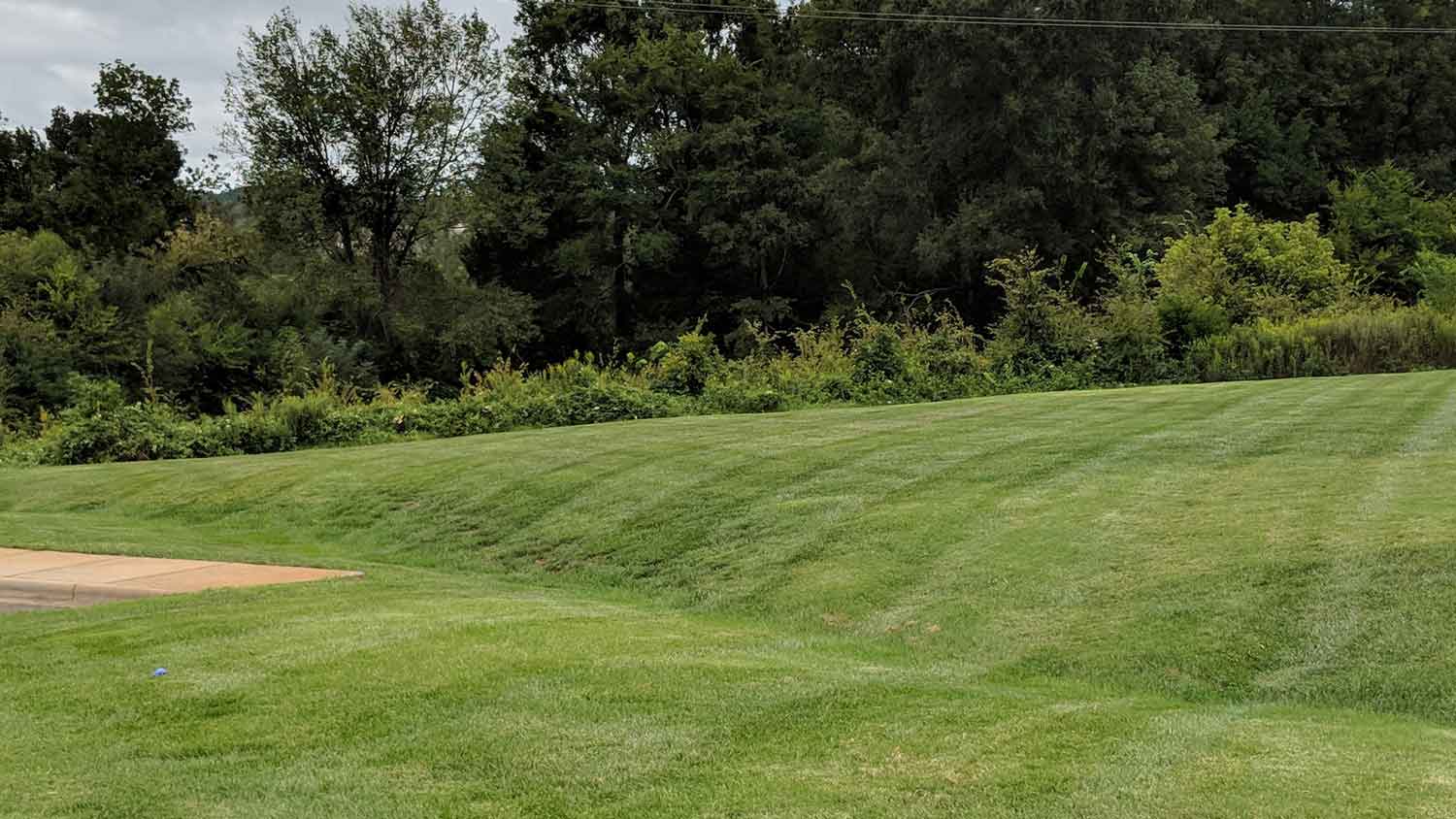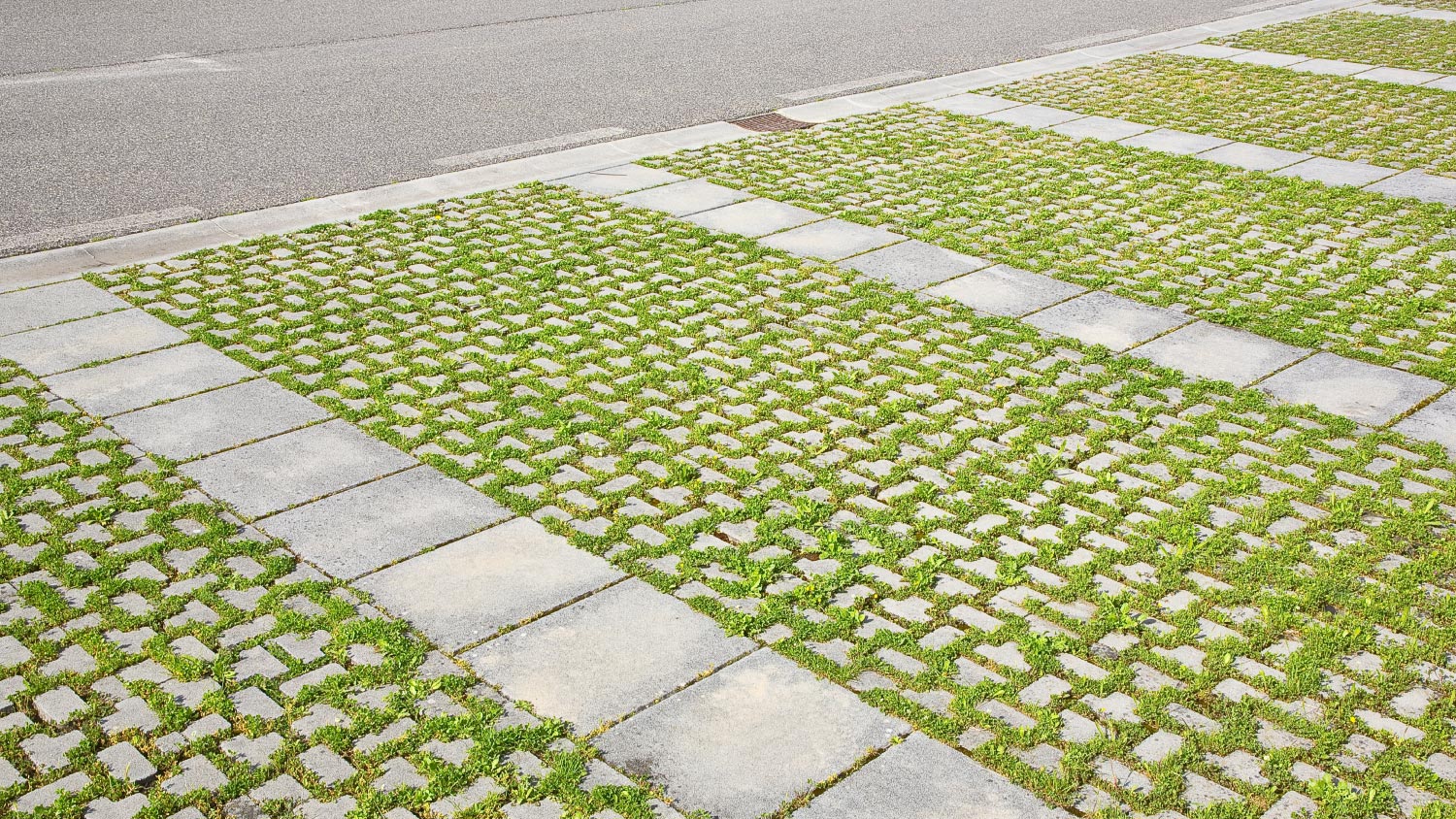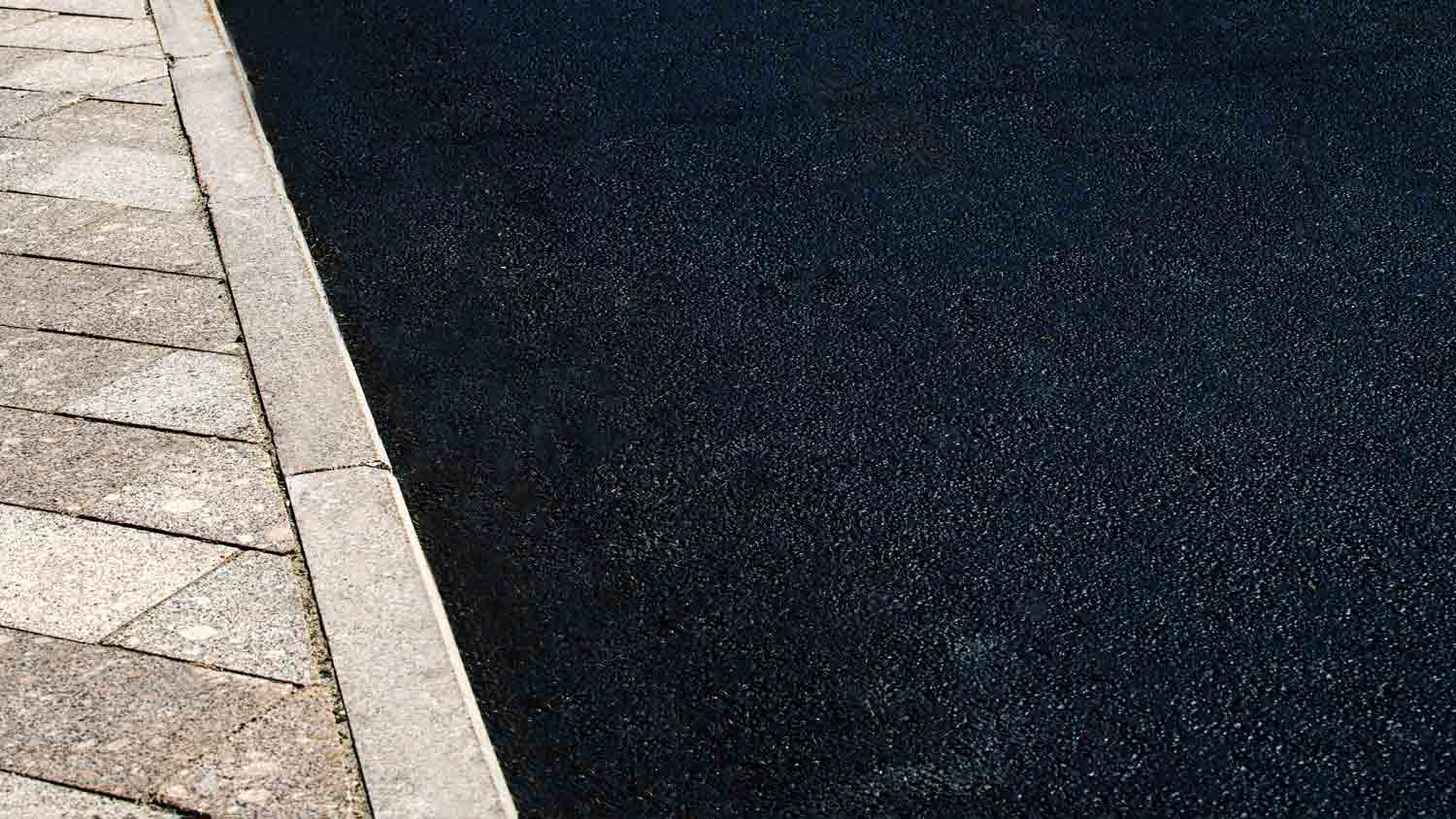
Use our guide to calculate the cost to seal an asphalt driveway. Prices vary based on the type of sealant and the size of the driveway.
Flush out annoying drainage problems with these methods


Rain can be beautiful and soothing—and it’s always a welcome relief after a scorching hot day. But rainfall is also a constant source of frustration for homeowners who deal with puddles of standing water in their driveway. Unfortunately, driveway drainage solutions are just one of many driveway problems homeowners often face. This guide covers specific steps for fixing driveway drainage problems so you can enjoy a properly drained driveway that lasts for years.
When taking on this project, expect questions only a pro can answer. With our network of local pros, you'll get the job done and your questions answered—without the hassle and stress of doing it yourself.
Water with no place to go can wear down your driveway faster—not to mention your soil and landscaping. Driveway materials and your mulch could wash away with the rainfall.
Plus, excess moisture isn’t good for your foundation. Driveways that don’t drain water away from the home will eventually reach your home’s structure, which could weaken or crack under poor drainage.
Pooling water, rocks and sand sitting on your driveway, and foundation issues are all signs of a drainage problem. If you notice these things after a rainstorm, it’s best to make a repair plan sooner rather than later.
You have a few options for rerouting water away from your driveway and home. Depending on the type of driveway and your aesthetic preference, you can choose between installing a channel drain, French drain, catch basin, swale, culvert, permeable pavers or by regrading.

Channel drains are a perfect drainage solution for sloped driveways since they’re installed inside the driveway, capturing water and channeling it to your designated location.
Channel drains—also known as trench drains—are ideal if your driveway is slightly sloped but sending all stormwater runoff on part of your yard, up against your foundation, or pooling in the street. The long rectangular drain catches the water exactly where it flows but redirects it either into a pipe, perforated drainage system, or your sewer.
Channel drain installation is an advanced DIY project. You will need a circular saw with a water jet to safely cut through the asphalt or concrete of your driveway. You will also need a pre-constructed channel drain, PVC piping to redirect the water, concrete, and an asphalt cold patch.
It is important to check with local laws before redirecting stormwater into the ground. You may need a permit or special permission to send the water into the sewer. Once you have the green light, check out the basic steps below:
Plan out your channel drain’s route along your driveway, then make a line showing the drain’s location. The drain needs to be lower than the pavement to help water flow.
Use a circular saw with a diamond-impregnated blade to cut through the driveway.
Dig a trench approximately 6 inches deep along the driveway.
Fit, connect, and glue drain pipes together on the side of the channel drain you want to direct water.
Mix concrete in a wheelbarrow and fill the trench with it.
Patch up and compact the gap between the channel drain and driveway with an asphalt cold patch.
French drain pipes collect water alongside a driveway away from your home using pipes with small holes on the top. While they are often compared to channel drains, French drains use a series of perforated pipes and fabric liner to filter the water slowly into the ground.
A French drain works with the natural slope of your yard to send water away from areas where it typically pools and causes issues. For example, if water gathers around the edge of your driveway and pours toward your garden, the French drain would begin at the trouble spot and run at an angle into a drainage area.
Purchase a pre-constructed French drain, PVC piping, gravel, sand, and fabric liner to layer the proper drainage solution for your driveway. You'll also need a shovel and land markers to plan out and excavate your trench.
Similar to before, always get a permit for redirecting stormwater and never send it into the sewer without permission. Basic installation steps include:
Mark the drainage route, placing land markers at every 50 feet, ensuring the grade slopes 6 inches per 50 feet.
Use a shovel to dig the trench deep and wide enough for the drain to be level.
Layer the bottom of your trench with gravel.
Add fabric lining on top of the gravel inside the entire length of your trench.
Completely cover the drain pipe with gravel, only leaving a small portion at the top exposed.
Fill the trench with sand, then cover with topsoil to grade.
A catch basin is a great driveway drainage solution (and also a great yard drainage solution). It involves installing a grate where water flows or pools on your driveway, with an in-ground container (the basin) that collects the water as it flows down through the grate. That water is then redirected away from the area, ideally to an existing storm drain.
The concept is similar to a public storm drain—but it’s a private one for your own property.
A catch basin makes the most sense if there’s an area of your sloped driveway where water regularly pools or if water flows off the driveway in one particular spot toward your yard or foundation. At this point, you’ll install the grate to catch the pooled water or runoff before it can do any damage.
Installing a catch basin is challenging work. You’ll need a saw that can cut into the driveway, a shovel for digging the trench, the basin itself, and the pipes that will direct water to the stormwater drain. You’ll also need to backfill the trench with gravel and dirt, and then replant grass in the part of your yard you’ve disrupted and fresh concrete for your driveway.
We highly recommend working with a drainage professional near you for this job. It is challenging work, both mentally and physically, requiring precise measurements and hard labor. The job also requires very specific (expensive) tools.
If you want to tackle installation yourself, you’ll need to obtain a permit before diverting water into the storm drain. Here’s a quick look at how to install the driveway catch basin:
Cut into the existing concrete where you’ll want to install the basin, as well as any portion of the driveway under which the pipes will run.
Dig out the hole for your catch basin and then the trench in your driveway and yard all the way to the storm drain. The predetermined route should be designed with a downward slope.
Install the catch basin in the hole, securing it with gravel and concrete.
Connect pipes from the basin to the storm drain.
Test the drainage by spraying water into the catch basin and ensuring it drains all the way to the storm drain.
Backfill the trenches and the hole with gravel and earth. Pour fresh concrete where necessary, and install the grate over the catch basin.

Swales are subtle depressions in a landscape where water can collect and flow toward a runoff point. In some cases, they pair with a French or channel drain. They're a good solution for driveways with drainage problems since the landscape on either side slopes toward it.
Place a swale close to where water runs off your driveway and gathers already. They are ideal for minor driveway drainage issues. Subtle swales are barely noticeable once the grass fills in, and you can hide deeper ones with rocks or plants, creating a custom landscape while you solve your drainage problem. Win-win, anyone?
Since swales are relatively easy installations, you'll only need a shovel, level, and landmarking flags. Once you dig out a U-shaped trench, you can fill the hole with gravel and topsoil for proper drainage.
The bottom of the swales needs to be at a lower elevation than the surface of your driveway, and the slope should fall at least 1 inch every 10 feet. It’ll collect water during storms, allowing it to enter the ground instead of flowing onto the driveway slowly. Here's the basic rundown of what to do:
Use a shovel to dig a U-shaped ditch with a slight slope of around 3 inches per 10 feet that the water can flow down while preventing erosions.
Line the swale with at least 3 inches of gravel.
Cover gravel with topsoil and sod.
Add your desired landscape.
One of the largest factors that determine how well your driveway drains water is its grade. If you're preparing to make major changes to your design, the cost of repaving your driveway should include an added fee for adding a slight slope.
All driveways should ideally have a slope of under 12%. The slight to mid-level grade ensures water funnels into the local sewer or road or away from your home's foundation. If your driveway goes over a 12% grade, you may need to investigate how to fix a steep driveway that's sending water too quickly in a given direction.
Regrading a paved driveway is not a DIY job, but you can get started by reaching out to a driveway repair team near you. These pros can help you determine if adjustments can be made without starting from scratch.
Gravel driveways are relatively easy to regrade, as you'll only need to temporarily relocate the top layer of gravel, excavate the ground at the lower end of the slope, and cover it back up. However, asphalt, concrete, and paver driveway regrading should be handled by a professional.

Often, drainage issues near a driveway are simply a result of the pavement preventing water from entering the ground. You can fix these drainage problems by getting a driveway repair company to install a driveway that allows water to pass through it.
Permeable driveways are built from materials that allow water to pass through, like concrete or recycled glass. Porous driveways use plastic, concrete, or stone in a grid pattern with space in between where water can pass through and grass can grow. Place permeable pavers in any driveway, but particularly those concerned with extreme drainage issues.
Similar to the other methods on this list, installing grass or permeable pavers is a rather advanced DIY. However, if you have the permit to install them yourself and are comfortable working with heavy materials, you'll need a layer of crushed stone and a premade permeable paving system. You may also need a stone cutter and a set of shovels for the complex excavation.
Since driveways hold a lot of weight, you may need to have your soil tested before starting to ensure it can hold the installation. Excavating of this size is also often best left to the professional, but if you decide to move ahead on your own, here are some steps to remember:
Cover the freshly excavated driveway with a 6-inch layer of crushed stone, compacting it twice.
Add a 4-inch layer of crushed stone over the existing one, compacting it twice.
Set the pavers on top of the bedding, double-checking that the pavers are close together.
Fill in paver joints with bedding stone.
Use a plate compactor on the entire driveway, locking the paving and bedding layers together.
Chances are that you've seen a culvert on the end of a driveway and didn't even know it had such a fancy name. A culvert pipe is a pipe that collects water, runs under something such as your driveway, and redirects the stormwater.
Culverts are ideal for major drainage issues, especially when you need to redirect constant water flow away from your driveway. Instead of sending the water through a filtration system on the ground, it sends the water flowing from an open pipe.
Yet again, installing a culvert is not a DIY job, especially if you need to follow strict laws about where and how the water leaves the pipe. However, you can get a sense of different driveway culvert ideas before calling a professional to start the installation.
Driveway culvert replacement can be costly—anywhere from $1,000 to $9,000—but the money saved on erosion and ruined turf is priceless. Speak with a professional and your local municipal office if your culvert is clogged or beginning to break down.
French drains, channel drains, swales, and permeable pavers will likely solve your drainage problem. Still, you can implement a few other solutions to ensure your driveway is protected during the heaviest rains.
Add plants and large trees to help absorb excess runoff.
Lay down permeable materials in other areas with drainage issues.
Install a rain barrel or cistern to catch runoff from your roof.
Redirect water from downspouts and gutters away from your driveway.
Your costs will fluctuate depending on your preferred driveway repair method.
A French drain costs anywhere from $1,000–$18,000.
A channel drain costs around $3,000–$9,000 per 100 lin. ft.
A swale system costs around $0.50 per foot to install.
Paver stones cost around $15–$60 per sq. ft.
Regrading a driveway costs around $1,500–$9,500.
Culvert installation costs around $1,000–$9,000.
If you decide to hire out for this project, foundation specialists, plumbers, and other certified professionals can install French drains or channel drains. Just make sure they have experience installing the specific type of drain you need outside your home. If installing pavers or swales, they might work hand in hand with a local landscape grading service to resolve your drainage problems.
Whether or not you should hire a pro to tackle your driveway drainage depends on the complexity of the project, your budget, and your own comfort level with the steps required. Most homeowners can tackle relatively simple tasks themselves, like adding permeable materials or installing a rain barrel, which can save you money on hiring a professional.
However, more complex projects, such as regrading your driveway or installing a French drain, require specialized knowledge and tools, so unless you have expertise and experience in the area, your best bet is to invest in a qualified professional. If you do decide to hire a pro, make sure to request quotes from several different prospects so you can find the right person and price for your project.
When interviewing potential pros for your drainage project, ask the following questions to help you find the right person for the job.
Can you provide references or photos of similar projects?
What permits will we need, and how will you handle that?
What is the projected timeline for the project?
Do you offer any warranties or guarantees for your work?
How do you handle unexpected issues or additional costs that may arise?
Who will be the primary contact for this project?
How will this project impact my property’s landscaping and appearance?
Can this drainage solution handle region-specific weather conditions?
What measures will you take to protect my property and the surrounding area during the project?
How will this project affect my property value?
What maintenance will be required for this drainage system?
From average costs to expert advice, get all the answers you need to get your job done.

Use our guide to calculate the cost to seal an asphalt driveway. Prices vary based on the type of sealant and the size of the driveway.

Asphalt driveway repair costs account for everything from hairline cracks to complete overhauls. Learn what to expect from your asphalt repair bill.

Do you need more parking for your business or home? Here's everything you need to know about the cost to pave a parking lot.

Asphalt driveways take anywhere from 48 to 72 hours to dry enough for vehicles. Stay tuned to learn more about how long before you can drive on asphalt.

Is tar still used in paving? How does it compare to asphalt? Learn their differences, from composition to durability, and why asphalt remains the top choice.

You know you need a bigger driveway, but what kind of extension should you add? Check out these driveway extension ideas to plan your new parking space.